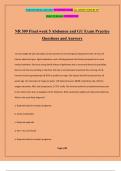©GRACEAMELIA 2024/2025 ACADEMIC YEAR. ALL RIGHTS RESERVED
FIRST PUBLISH OCTOBER 2024
NR 509 Final week 5 Abdomen and GU Exam Practice
Questions and Answers
An overweight 26-year-old public servant presents to the Emergency Department with 12 hours of
intense abdominal pain, light-headedness, and a fainting episode that finally prompted her to seek
medical attention. She has a strong family history of gallstones and is concerned about this possibility.
She has not had any vomiting or diarrhea. She had a normal bowel movement this morning. Her β-
human chorionic gonadotropin (β-hCG) is positive at triage. She reports that her last period was 10
weeks ago. Her vital signs at triage are pulse, 118; blood pressure, 86/68; respiratory rate, 20/min;
oxygen saturation, 99%; and temperature, 37.3ºC orally. The clinician performs an abdominal exam prior
to her pelvic exam and, on palpation of her abdomen, finds involuntary rigidity and rebound tenderness.
What is the most likely diagnosis?
a. Ruptured tubal (or ectopic) pregnancy
b. Acute cholecystitis
c. Ruptured appendix
d. Perf - Ans:✔✔-Good!
a. Ruptured tubal (or ectopic) pregnancy
Page 1/48
, ©GRACEAMELIA 2024/2025 ACADEMIC YEAR. ALL RIGHTS RESERVED
FIRST PUBLISH OCTOBER 2024
Rationale: The constellation of abdominal pain, syncope, tachycardia, hypotension, positive β-hCG, and
findings suggestive of peritoneal inflammation/irritation strongly suggest a ruptured ectopic pregnancy
with significant intra-abdominal bleeding leading to peritoneal signs. This case is emergent and requires
immediate treatment of her hypotension and presumed blood loss as well as gynecological consult for
emergent surgery. Ruptured ectopic pregnancies can lead to life-threatening intra-abdominal bleeding.
Although acute cholecystitis, ruptured appendix, bowel wall perforation, and ruptured ovarian cyst are
all possibilities, the positive β-hCG testing and her unstable vital signs make ruptured ectopic pregnancy
more likely.
2. A 63-year-old janitor with a history of adenomatous colonic polyps presents for a well visit. Basic labs
are performed to screen for diabetes mellitus and dyslipidemia. Electrolytes and liver enzymes were also
measured. His labs are all normal expect for moderate elevations of aspartate aminotransferase, alanine
aminotransferase, γ-glutamyl transferase, and alkaline phosphatase as well as a mildly elevated total
bilirubin. He presents for a follow-up appointment and the clinician performs an abdominal exam to
assess his liver. Which of the following findings would be most consistent with hepatomegaly?
a. Liver span of 11 cm at the midclavicular line
b. Liver span of 8 cm at the midsternal line
c. Dullness to percussion over a span of 11 cm at the midclavicular line
d. Dullness to percussion over a span of 8 cm at the midsternal line
Page 2/48
, ©GRACEAMELIA 2024/2025 ACADEMIC YEAR. ALL RIGHTS RESERVED
FIRST PUBLISH OCTOBER 2024
e. Liver palpable 3 cm below the right costal margin, mid clavicular line, on expi - Ans:✔✔-e. Liver
palpable 3 cm below the right costal margin, mid clavicular line, on expiration
Rationale: The liver being palpable 3 cm below the right costal margin, midclavicular line, would be
considered normal on inspiration when the liver is pushed down into the abdominal cavity on
inspiration, but is abnormal on expiration.
Findings to support hepatomegaly would be more convincing if, by percussion, the liver span was >12 cm
at the midclavicular line.
For patients with obstructive lung disease, air trapping in the lungs may displace the liver downwards
into the abdominal cavity.
The liver span and dullness to percussion refer to the same measurement. Measurements of 6-12 cm at
the mid-clavicular line and 4-8 cm at the midsternal line are considered normal.
3. A 63-year-old underweight administrative clerk with a 50-pack-year smoking history presents with a
several month history of recurrent epigastric abdominal discomfort. She feels fairly well otherwise and
denies any nausea, vomiting, diarrhea, or constipation. She reports that a first cousin died from a
ruptured aneurysm at age 68 years. Her vital signs are pulse, 86; blood pressure, 148/92; respiratory
Page 3/48
, ©GRACEAMELIA 2024/2025 ACADEMIC YEAR. ALL RIGHTS RESERVED
FIRST PUBLISH OCTOBER 2024
rate, 16; oxygen saturation, 95%; and temperature, 36.2ºC. Her body mass index is 17.6. On exam, her
abdominal aorta is prominent, which is concerning for an abdominal aortic aneurysm (AAA). Which of
the following is her most significant risk factor for an AAA?
a. Female gender
b. History of smoking
c. Underweight
d. Family history of ruptured aneurysm
e. Hypertension - Ans:✔✔-b. History of smoking
Rationale: History of smoking is her most significant risk factor for an AAA.
Male gender, not female gender, is considered as risk factor.
Underweight is not a risk factor for AAA. Family history of ruptured aneurysm is vague and could be a
cerebral aneurysm.
Page 4/48




